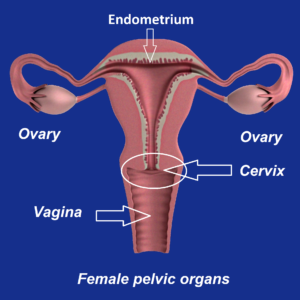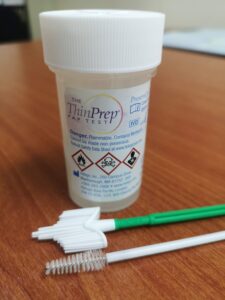 The cervical cytology smear was previously referred to as Pap smear. It is a test carried out to detect pre-cancerous and cancerous cell changes in the cervix.
The cervical cytology smear was previously referred to as Pap smear. It is a test carried out to detect pre-cancerous and cancerous cell changes in the cervix.
Worldwide, cervical cancer is the fourth most common cancer in women. In Malaysia, cervical cancer is the third most common cancer among women and the seventh-highest among the entire population (Malaysia National Cancer Registry report (MNCRR), 2007 – 2011). The good news is that it can be prevented via widespread vaccination with Human Papilloma Virus (HPV) vaccine among the younger age groups and regular screening for precancerous lesions of the cervix with cervical cytology smear. Pre-cancerous lesions of the cervix can be treated easily and this will prevent further development into cancer and can save lives.
 Reasons for the test
Reasons for the test
- As part of routine cancer screening.
- Investigate the cause of abnormal vaginal bleeding or discharge.
- Bleeding after sexual intercourse
How is it done?
 It is a simple and relatively painless office procedure. Sometimes, some discomfort or pain may be felt and you should tell the doctor who is performing it so that the speculum can be adjusted to ease the discomfort.
It is a simple and relatively painless office procedure. Sometimes, some discomfort or pain may be felt and you should tell the doctor who is performing it so that the speculum can be adjusted to ease the discomfort.
The examination is performed in the clinic. It usually takes about 10 minutes. You will need to lie on your back on the examination bed, with knees bent and legs are apart. The external genital will be examined visually for abnormalities (abnormal lumps, sores, skin discoloration or inflammation)
A well-lubricated speculum is placed inside the vagina and opened. The speculum is an instrument that holds the vaginal walls apart and allows the examiner to see the cervix and vagina and check for inflammation, infection or growths. There may be some feeling of pressure on the bladder or rectum with the speculum in place. With A small brush, a collection of cells is taken from the cervix and transferred to a small container with a preservative fluid. This type of collection is called liquid-based cytology (LBC). This has replaced the old conventional method of smearing the collection onto a slide. Currently, the LBC cervical cancer screening method is better and more accurate compared to the conventional Pap smear test.
If you have an infection or there are signs of infection present, a sample of vaginal or cervical discharge may be taken for laboratory analysis at the same time.
How frequent?
 It is recommended that women should go for a cervical cytology smear once they are above the age of 21 and already sexually active. The interval is every 3 to 5 years. A more frequent screening (every 6 to 12 months) may be necessary if the women are at high risk of developing cervical cancer or had an abnormal smear in the past. Some doctors still recommend annual smears as a routine. The basis for a 3 to 5 years smear is that cervical cancer is a slow progressive condition and usually takes 10 to 15 years to transform into full-blown cancer. Therefore, a 3 to 5 years smear will be sufficient to detect the pre-cancer stage. The cost-benefits ratio is also taken into consideration for this extended recommendation. Those who favour a once-a-year smear argue that the test is not 100% accurate and it depends on so many factors such as the person taking the sample and the laboratory which analyses the sample. Yearly smear can minimize the risk of inaccurate results since it is rare to get a false negative test 2 or 3 years in a row. Furthermore, once-a-year testing makes it easier for women to remember. Many women will find it difficult to remember when the last time smear was done, was it 2, 3 or even 5 years ago. This increases the risk of skipping the test and missing out on the early diagnosis.
It is recommended that women should go for a cervical cytology smear once they are above the age of 21 and already sexually active. The interval is every 3 to 5 years. A more frequent screening (every 6 to 12 months) may be necessary if the women are at high risk of developing cervical cancer or had an abnormal smear in the past. Some doctors still recommend annual smears as a routine. The basis for a 3 to 5 years smear is that cervical cancer is a slow progressive condition and usually takes 10 to 15 years to transform into full-blown cancer. Therefore, a 3 to 5 years smear will be sufficient to detect the pre-cancer stage. The cost-benefits ratio is also taken into consideration for this extended recommendation. Those who favour a once-a-year smear argue that the test is not 100% accurate and it depends on so many factors such as the person taking the sample and the laboratory which analyses the sample. Yearly smear can minimize the risk of inaccurate results since it is rare to get a false negative test 2 or 3 years in a row. Furthermore, once-a-year testing makes it easier for women to remember. Many women will find it difficult to remember when the last time smear was done, was it 2, 3 or even 5 years ago. This increases the risk of skipping the test and missing out on the early diagnosis.
In the future, the inclusion of the HPV DNA testing into the cervical cancer screening program will make the testing more accurate to pick up precancerous change of the cervix. Studies have shown that if the cervical cytology smear is normal and/or there is no HPV infection, then the risk of pre-cancerous or cancer of the cervix is extremely low and the screening interval can extend for as long as 3 to 5 years.
How to prepare for the test?
 Women should not be menstruating or have sperm present in the vagina from recent intercourse. Therefore, women should avoid sexual intercourse within a period of 24 hours prior to the procedure.
Women should not be menstruating or have sperm present in the vagina from recent intercourse. Therefore, women should avoid sexual intercourse within a period of 24 hours prior to the procedure.
Do not douche, use tampons, or use vaginal medications for at least 24 hours before having the test.
The smear can be done during pregnancy. However, it is not routine and only done when there is an indication for it.
What to expect after the test?
- There may be some slight bleeding or discharge following the test. Use a tissue to wipe or wear a panty liner.
- The results of the smear testing may take a few days to two weeks to be available to you.

- A positive test may indicate that there are some cells changes that need further investigations but do not necessarily indicate a pre-cancerous or a cancerous condition of the cervix. Further testing or a colposcopy or even a biopsy may be indicated to confirm the abnormality.
- Sometimes the smear report may indicate the presence of infection and treatment may be given.
- One must be aware that the cervical cytology smear is not 100% accurate and the need for regular repeat smear as per recommended interval is important to ensure that the precancerous changes are not missed in the future.
- You can drive or return to work immediately if you wish.
- There is no dietary or activity restriction.
To print a pdf copy, click HERE
[mailerlite_form form_id=3]



